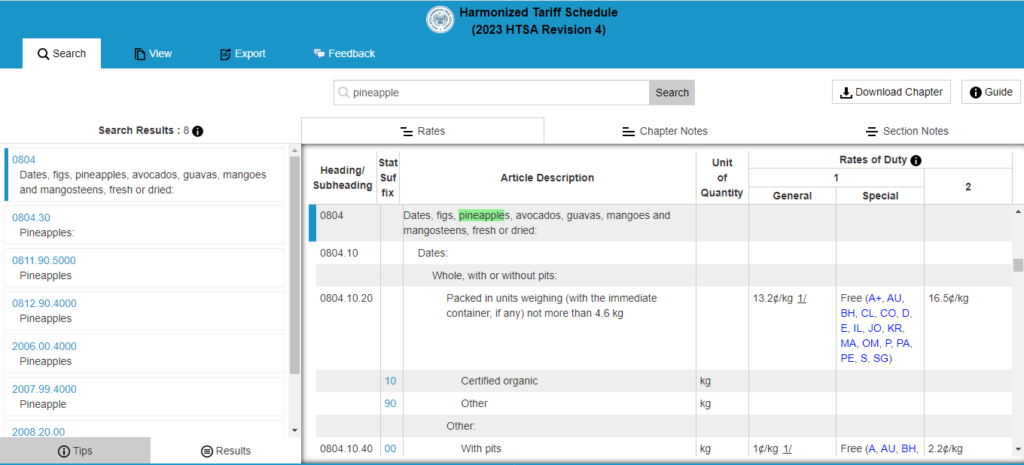Shipping packing lists are essential documents that provide critical information about the contents of a shipment. This document details important information such as the item name, quantity, weight, dimensions, country of origin, value, HS code, and packaging details. The purpose of the shipping packing list is to ensure that the right items are shipped, delivered, and accounted for in the destination country.
It helps customs officials to verify the contents of the shipment and identify any prohibited or restricted items. The accuracy of the packing list is crucial for avoiding delays in transit, customs clearance, or delivery, and for preventing fines or other penalties.
This article discusses how to create a shipping packing list, who creates it, and tips for using it effectively to ensure that your shipments arrive at their intended destination without any issues.
DocShipper info: DocShipper is the freight forwarder that will arrange your freight shipping from the beginning to the end. We take care of all the documents, including creating accurate and detailed shipping packing lists. With our help, you can rest assured that your shipments will arrive safely and on time, without any surprises or delays. Contact us today to learn more about how we can help you streamline your shipping process.
What’s a packing list
A shipping packing list is a document that accompanies a shipment of goods, providing a detailed list of the items included in the shipment. It is an important document in the shipping process because it helps to ensure that the recipient receives the correct items in the correct quantities and facilitates the customs clearance process if the shipment crosses international borders.
The packing list is usually created by the shipper or the manufacturer and is included in the shipping documents that are sent with the goods. It can also help to resolve any disputes or issues that may arise during the shipment process.
What information does a shipping packing list include?
The exact information included on a shipping packing list may vary depending on the type of goods being shipped and the requirements of the recipient or customs officials. A shipping packing list generally includes information such as the item name, quantity, weight, and dimensions.
In addition, the country of origin, value, and HS code may also be included to facilitate customs clearance. The packaging details, such as the type of packaging used, may also be listed. Other relevant details such as batch numbers, serial numbers, or expiration dates may also be included as needed.
Docshipper advice: Do you want your shipments to arrive smoothly with accurate shipping packing lists? DocShipper can help you create comprehensive packing lists tailored to your specific needs, so you can avoid delays and customs issues. Contact us today to learn more about our freight forwarding services and how we can help you streamline your shipping process.
Item name
The item name is a description of the items included in the shipment. This could be a generic or specific name, depending on the type of goods. For instance, if the shipment contains clothing items, the item name could be "men's t-shirts" or "women's dresses". Another example would be If the shipment contains electronic components, the item name could be more specific, such as "microcontrollers" or "LED displays".
The item name is important because it helps the recipient and customs officials identify and classify the items being shipped, and it helps ensure that the correct items are included in the shipment and that the recipient knows what to expect when receiving the goods. In addition to that, including a detailed and accurate item name on the packing list can help prevent any confusion or misunderstandings that could arise during the shipping process.
Quantity
The quantity refers to the number of items included in the shipment. This will help the recipient verify that they have received the correct number of items that they were expecting to receive.
The quantity information on the packing list can be used to ensure that the weight and dimensions of the shipment are accurate. This information is important for calculating shipping costs and ensuring that the shipment meets any weight or size restrictions that may be in place.
 Weight
Weight
The weight of each item and the total weight of the shipment. This information is important for ensuring that the shipment meets any weight restrictions that may be in place, calculating shipping costs accurately, and facilitating customs clearance.
Customs officials may use the weight information to verify that the shipment matches the description on the customs declaration and to identify any discrepancies.
Dimensions
The size of each item and the total size of the shipment. It is important to have accurate dimensions, as that will ensure safe packaging, which could help to prevent damage to the items during transit. Accurate dimensions are also necessary for calculating shipping costs.
Lastly, dimensions can also be important for customs clearance. Customs officials may use the dimensions to verify that the shipment matches the description on the customs declaration and to identify any discrepancies that may require further investigation.
The country of origin
The country where the goods were produced or manufactured. This information is crucial, as it helps customs officials identify the origin of the goods and determine the appropriate tariffs and duties that may apply. Another reason for its importance is that some products may require additional inspection or clearance based on their country of origin due to health and safety regulations, intellectual property restrictions, or other trade agreements.
Value
The value typically refers to the declared value of the goods being shipped. The declared value is the estimated value of the goods used to calculate the customs duties and taxes that may be due on the shipment.
The declared value is important because it helps customs officials determine the appropriate amount of duties and taxes to charge for the shipment. If the declared value is inaccurate or incomplete, it could result in delays in customs clearance, or additional charges being assessed.
Aside from that, it can also be important for insurance purposes. In case the shipment is lost, damaged or stolen during transit, the declared value is used to determine the amount of compensation that the shipper will receive from the carrier or insurance provider.
HS code
The Harmonized System code, known as the HS code, refers to a standardized system of names and numbers used to classify traded products. Each product is assigned a unique HS code based on its nature, composition, and intended use.
An important element of the packing list, it is used by customs officials to identify the type of product being shipped and to apply the appropriate tariffs, taxes, and regulations. It is also used by carriers and logistics providers to determine the most efficient and cost-effective shipping methods and to prepare the necessary documentation for the shipment.
The packaging details
Packaging details refer to the type of packaging used to transport the goods, as well as any information related to the packaging's weight, dimensions, and materials.
Packaging information helps carriers and logistics providers to determine the most appropriate shipping methods and to estimate the shipping costs. Accurate packaging information can help to prevent damage to the goods during transit by ensuring that they are packaged appropriately for the mode of transportation being used.
Packaging details are often required by customs officials as part of the documentation needed for customs clearance. For example, some countries may require specific markings or labels on the packaging, or may have regulations regarding the materials that can be used for packaging.
How to create a shipping packing list
Creating a shipping packing list involves several steps. Here is a general outline of the process:
Gather information
Collect all the necessary information about the goods being shipped, including the item name, quantity, weight, dimensions, country of origin, value, HS code, and packaging details.
Choose a template
Select a shipping packing list template that is suitable for your needs. There are many free templates available online that can be customized to meet your specific requirements.
Enter the information
Enter the information about the goods being shipped into the appropriate fields of the packing list template. Make sure to include all the required details, and double-check that the information is accurate and complete.
Review and edit
Review the completed packing list for any errors or omissions, and make any necessary edits or additions.
Print and attach
Print the packing list and attach it to the outside of the shipment, along with any other required shipping documents.
Send the shipment
Send the shipment to the recipient using the selected shipping method.
Docshipper advice: Are you interested in simplifying the process of creating a shipping packing list? Our team of experts can assist you in gathering and entering the necessary information, choosing a suitable template, reviewing and editing the completed list, and ensuring that all required documents are properly attached to the shipment. Contact us today to learn how we can help streamline your shipping process and ensure that your shipments arrive at their destination without any issues.
Who creates the shipping packing list?
The shipping packing list is usually created by the shipper, which is typically the company or individual who is sending the goods. The shipper is responsible for preparing all of the necessary documentation for the shipment, including the packing list, and for ensuring that the shipment complies with all relevant regulations and requirements.
In some cases, you (as a shipper) may use a freight forwarder (DocShipper) or customs broker to assist with the preparation of the packing list and other shipping documents. Freight forwarders and customs brokers are third-party service providers who specialize in handling the logistics and regulatory requirements of international shipping.
Regardless of who creates the packing list, it is important that the information contained in the document is accurate and complete, as any errors or omissions could result in delays in customs clearance or additional charges being assessed, which could ultimately impact the delivery time and cost of the shipment.
The potential consequences of inaccurate packing lists
It is vital to ensure that the packing list is accurate and complete to avoid potential consequences that can impact the delivery time, cost, and safety of the shipment. The potential consequences of inaccurate packing lists include:
Customs delays
Customs officials may require additional documentation or inspections if they find errors or discrepancies in the packing list. This can lead to delays in the clearance process and may result in additional charges or penalties.
Higher shipping costs
Incorrect information on the packing list can result in incorrect weight or dimension calculations, which can lead to higher shipping costs. In some cases, carriers may refuse to transport the shipment until the correct information is provided.
Damage to goods
If the goods are not properly packaged or labeled, they may be subject to damage during transportation. This can result in the loss of goods or additional costs for repairs or replacements.
Legal consequences
In some cases, inaccurate packing lists may be considered a violation of import/export laws and regulations. This can result in fines, penalties, or legal action against the shipper.
DocShipper Alert: Accurate packing lists can build trust and encourage repeat business through transparency and quality assurance. Providing a detailed list allows customers to verify received items and increases confidence. It also serves as a quality check to ensure correct shipment, reducing errors and enhancing the customer experience.
Tips for Using Shipping Packing Lists Effectively
To use shipping packing lists effectively, it's important to use a standard format, double-check for accuracy, and include all required information such as the HS code, country of origin, and packaging details. In addition to that, each package should be labeled clearly with a unique identifier that matches the packing list to ensure that each package is accounted for and delivered to the correct location.
By following these tips, businesses can ensure that their shipping packing lists are accurate and complete, which helps to build trust with customers and minimize the risk of errors or delays in customs clearance and shipping.
DocShipper info : Ready to ship? Don't worry if you don't understand everything, logistics is a complex process and DocShipper will make it easier by taking care of everything. Contact us today for a free quote in 24h.
FAQ | Shipping Packing List: Everything You Should Know
What are some common mistakes to avoid when creating a packing list?
Some common mistakes to avoid when creating a packing list include inaccurate or incomplete information, missing required details, illegible writing, inconsistent formatting, and failing to review the list for accuracy. These mistakes can lead to delays and other issues during the shipping process. To prevent these problems, ensure all information is accurate and complete, include all required details, use clear and consistent formatting, and carefully review the packing list before submitting it.
What should I do if I discover an error on my packing list after it has already been submitted?
If you discover an error on your packing list after it has already been submitted, it is important to notify the relevant parties as soon as possible. Contact your shipping carrier and provide them with the correct information. Depending on the severity of the error, it may be necessary to cancel the shipment and resubmit a corrected packing list. In any case, be sure to review your packing list thoroughly before submitting it to minimize the risk of errors.
Is the shipping packing list strictly required?
The shipping packing list is an important document in the shipping process and is typically required by customs authorities. It provides critical information about the contents of a shipment and ensures that the goods are properly identified, handled, and accounted for. Failing to provide a shipping packing list can lead to delays, fines, or even seizure of the shipment by customs. Therefore, it is highly recommended to create a shipping packing list and include it with your shipment to avoid any potential issues.
Can I do the shipping packing list by myself without any help?
Yes, you can create a shipping packing list by yourself without any help. However, it is important to ensure that the information included on the packing list is accurate and complete and that you use a template or software to help you create the packing list to avoid any potential errors. In addition to that , it is important to have a good understanding of the shipping requirements and regulations of the destination country to ensure that the packing list is compliant with their regulations.
DocShipper info: Do you like our article today? For your business interest, you may like the following useful articles :
DocShipper Advice: We help you with the entire sourcing process so don't hesitate to contact us if you have any questions!
- Having trouble finding the appropriate product? Enjoy our sourcing services, we directly find the right suppliers for you!
- You don't trust your supplier? Ask our experts to do quality control to guarantee the condition of your goods!
- Do you need help with the logistics? Our international freight department supports you with door to door services!
- You don't want to handle distribution? Our 3PL department will handle the storage, order fulfillment, and last-mile delivery!
DocShipper China | Procurement - Quality control - Logistics
Alibaba, Dhgate, made-in-china... Many know of websites to get supplies in Asia, but how many have come across a scam ?! It is very risky to pay an Asian supplier halfway around the world based only on promises! DocShipper offers you complete procurement services integrating logistics needs: purchasing, quality control, customization, licensing, transport...
Communication is important, which is why we strive to discuss in the most suitable way for you!




 Weight
Weight






